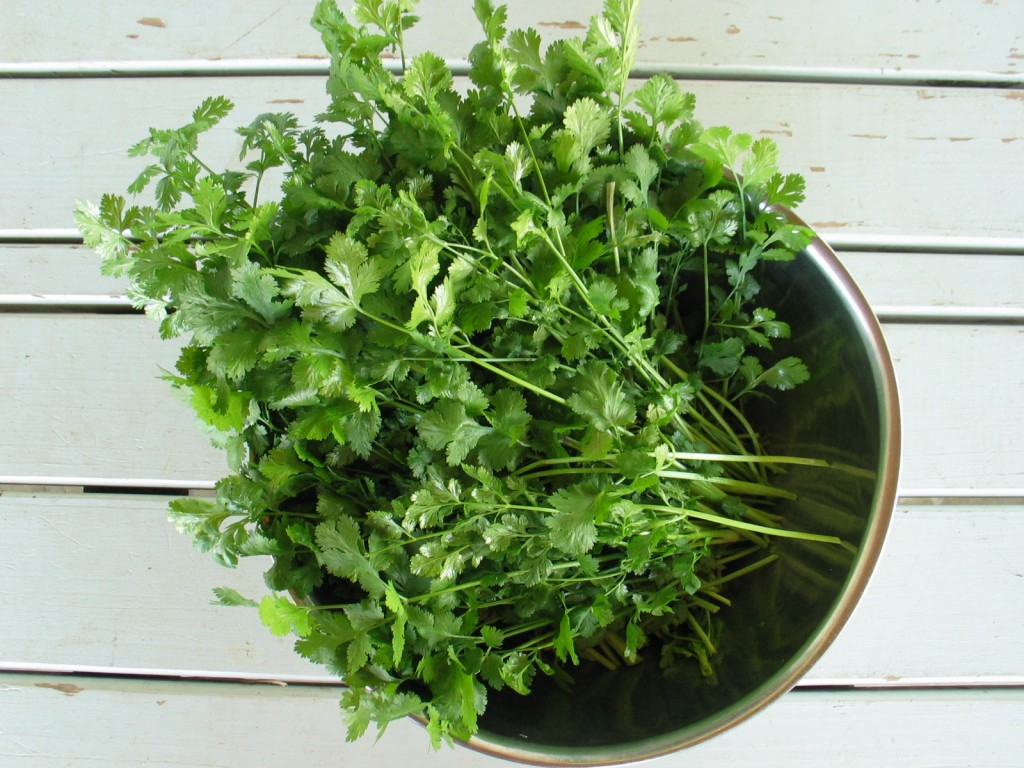by Alison Kinney
When I was seventeen, my family attended a supper hosted by the Vietnamese-American Presbyterian church one town over. We’d never sampled Vietnamese food before; we had no idea what to expect, apart from a break in the churchly routine of roasts-and-pie, fish-and-chips, and Jell-O salad. We were slightly disappointed, but mostly relieved, that the chicken, beef, and rice dishes resembled the Chinese takeout we enjoyed.
That is, until I tried the soup: chicken broth with translucent noodles, chicken breast, and floating disks of scallion, along with some lacy, parsley-shaped leaves. One of the leaves stuck to my front teeth; I licked it off, chewed, and shuddered. “There’s something wrong with the soup,” I told my parents.
“It’s just chicken,” they hissed.
I took another sip and tasted something chemical, like soap, perfume, or embalming fluid. Or was it radioactive? It made my teeth ache. When I swallowed, a jolt shivered down my spine and into my nerve endings. I felt poisoned, maybe electrocuted.
It was my first taste of cilantro.
The aversion to cilantro has attracted a lot of Internet noise, because some research suggests that it’s genetic. People who’ve experienced the horror I felt that day—and felt again when I first tasted green curry and salsa—are only too happy to conclude that it’s hard-wired.
I no longer tasted the soapiness, shuddered with revulsion, or believed I was being poisoned. This time, I detected lemon and maple, a not unpleasant hint of green grass, and that unmistakeable cilantro flavor. If there was still a frisson in my backbone, it was only a thrill of surprise.
But our behaviors and attitudes, including our tastes, are complex processes that involve a lot more than Hate/Love, On/Off switches in our DNA. I discovered this when I was nineteen and dating a man who liked to cook with a lot of cilantro. He put cilantro in stir-fries, bean soup, and burritos, and I, gagging and sniveling, picked it out, frond by frond. He took me to a Thai restaurant where I tasted that horrifying first green curry, then another Thai restaurant, and an Indian restaurant. He chopped raw tomatoes—I hated raw tomatoes, too—and whole bunches of cilantro into salsa, opened a bag of tortilla chips, and said, “That’s dinner tonight.”
I have no idea why he was so persistent, but one day, several months and dozens of meals later, I felt a craving for salsa. He whipped up a mixing-bowl full and I ate half of it in one go. I no longer tasted the soapiness, shuddered with revulsion, or believed I was being poisoned. This time, I detected lemon and maple, a not unpleasant hint of green grass, and that unmistakeable cilantro flavor. If there was still a frisson in my backbone, it was only a thrill of surprise.
Whatever genetic inclinations I may have once had were now mingled with memories, the exhilaration of a new relationship, and a palate that had been shocked against its will into expanding. The disgust I’d felt at that church supper was real, based on the incontestable evidence of my senses, and visceral in the most literal way: I’d allowed a foreign body to pass my outraged tongue and enter my poor, vulnerable guts. But one of the privileges of growing up is to be given the chance to re-feel, re-sense, reinterpret our reactions, and discover pleasure where we’d previously only known bleh. Our gut reactions can change.
That boyfriend also taught me to cook, and the first thing I made was salsa.
Without cilantro’s tough love, I might never have come around to any of the foods that used to sicken me: besides raw tomatoes, every kind of cheese. And bananas. Pretzels. Strawberries. Mushrooms. Apples. Peppers. Sweet potatoes. Avocados. Licorice. Asparagus. Ham. Brownies. Green beans. Cantaloupe. Pine nuts. Peanut butter. Cinnamon. Oreos. Rare meat. Granulated sugar; I was the kid who discarded most of her Halloween candy because of the gritty bits.
Learning to love these foods wasn’t about mind over matter; it was a continual reassessment of the relationship between mind and matter. I began to want to eat food, not as something to like or dislike instantaneously and unthinkingly, but as an experience to regard with interest even, and especially, when my first reaction wasn’t delight. I wanted to learn how a food might change my mind, which is not always a comfortable process.
I spent much of last year living in France. On a vacation to the southwest, I ordered a goose gizzard salad for a first course. It was strange, overwhelming, and so tasty I cleaned the plate. At the end of the meal, I bit into a piece of aged local cheese. It was odd and overwhelming, and, to my embarrassment, I gagged. It was a learning experience.
But after a week of fatty fowls and organ meats, I returned to the markets of Paris, where I bought cilantro to stir-fry with cabbage, eggs, and sesame oil: for freshness, simplicity, a different shock to the palate, and a taste of the beloved and familiar.
Alison received her M.F.A. in Creative Writing from The New School. Her writing has appeared in Gastronomica, The Robert Olen Butler Prize Stories, The Literary Review, and The Blue Mesa Review.


Comments are closed.